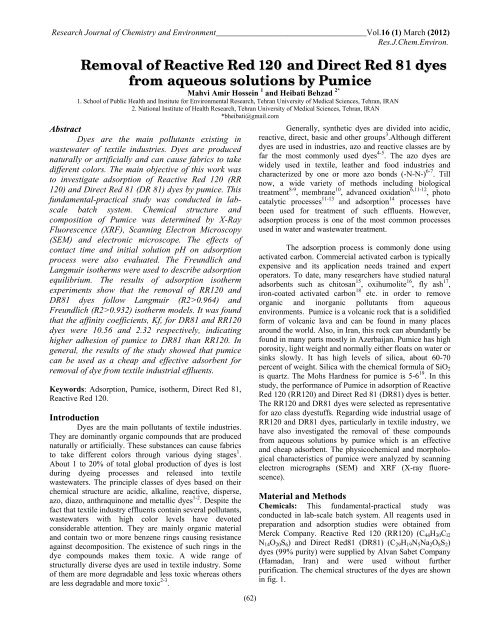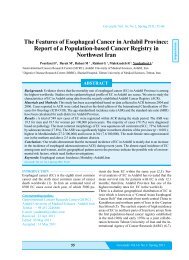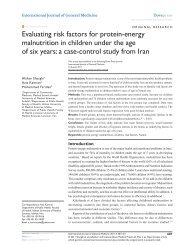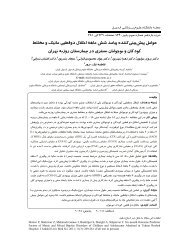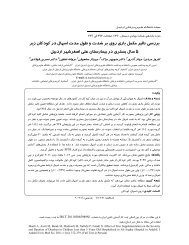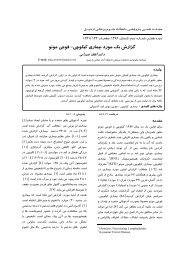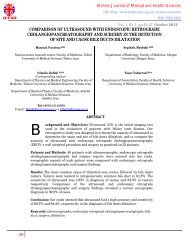Removal of Reactive Red 120 and Direct Red 81 dyes from ...
Removal of Reactive Red 120 and Direct Red 81 dyes from ...
Removal of Reactive Red 120 and Direct Red 81 dyes from ...
You also want an ePaper? Increase the reach of your titles
YUMPU automatically turns print PDFs into web optimized ePapers that Google loves.
Research Journal <strong>of</strong> Chemistry <strong>and</strong> Environment____________________________________Vol.16 (1) March (2012)Res.J.Chem.Environ.<strong>Removal</strong> <strong>of</strong> <strong>Reactive</strong> <strong>Red</strong> <strong>120</strong> <strong>and</strong> <strong>Direct</strong> <strong>Red</strong> <strong>81</strong> <strong>dyes</strong><strong>from</strong> aqueous solutions by PumiceMahvi Amir Hossein 1 <strong>and</strong> Heibati Behzad 2*1. School <strong>of</strong> Public Health <strong>and</strong> Institute for Environmental Research, Tehran University <strong>of</strong> Medical Sciences, Tehran, IRAN2. National Institute <strong>of</strong> Health Research, Tehran University <strong>of</strong> Medical Sciences, Tehran, IRAN*bheibati@gmail.comAbstractDyes are the main pollutants existing inwastewater <strong>of</strong> textile industries. Dyes are producednaturally or artificially <strong>and</strong> can cause fabrics to takedifferent colors. The main objective <strong>of</strong> this work wasto investigate adsorption <strong>of</strong> <strong>Reactive</strong> <strong>Red</strong> <strong>120</strong> (RR<strong>120</strong>) <strong>and</strong> <strong>Direct</strong> <strong>Red</strong> <strong>81</strong> (DR <strong>81</strong>) <strong>dyes</strong> by pumice. Thisfundamental-practical study was conducted in labscalebatch system. Chemical structure <strong>and</strong>composition <strong>of</strong> Pumice was determined by X-RayFluorescence (XRF), Scanning Electron Microscopy(SEM) <strong>and</strong> electronic microscope. The effects <strong>of</strong>contact time <strong>and</strong> initial solution pH on adsorptionprocess were also evaluated. The Freundlich <strong>and</strong>Langmuir isotherms were used to describe adsorptionequilibrium. The results <strong>of</strong> adsorption isothermexperiments show that the removal <strong>of</strong> RR<strong>120</strong> <strong>and</strong>DR<strong>81</strong> <strong>dyes</strong> follow Langmuir (R2>0.964) <strong>and</strong>Freundlich (R2>0.932) isotherm models. It was foundthat the affinity coefficients, Kf, for DR<strong>81</strong> <strong>and</strong> RR<strong>120</strong><strong>dyes</strong> were 10.56 <strong>and</strong> 2.32 respectively, indicatinghigher adhesion <strong>of</strong> pumice to DR<strong>81</strong> than RR<strong>120</strong>. Ingeneral, the results <strong>of</strong> the study showed that pumicecan be used as a cheap <strong>and</strong> effective adsorbent forremoval <strong>of</strong> dye <strong>from</strong> textile industrial effluents.Keywords: Adsorption, Pumice, isotherm, <strong>Direct</strong> <strong>Red</strong> <strong>81</strong>,<strong>Reactive</strong> <strong>Red</strong> <strong>120</strong>.IntroductionDyes are the main pollutants <strong>of</strong> textile industries.They are dominantly organic compounds that are producednaturally or artificially. These substances can cause fabricsto take different colors through various dying stages 1 .About 1 to 20% <strong>of</strong> total global production <strong>of</strong> <strong>dyes</strong> is lostduring dyeing processes <strong>and</strong> released into textilewastewaters. The principle classes <strong>of</strong> <strong>dyes</strong> based on theirchemical structure are acidic, alkaline, reactive, disperse,azo, diazo, anthraquinone <strong>and</strong> metallic <strong>dyes</strong> 1-2 . Despite thefact that textile industry effluents contain several pollutants,wastewaters with high color levels have devotedconsiderable attention. They are mainly organic material<strong>and</strong> contain two or more benzene rings causing resistanceagainst decomposition. The existence <strong>of</strong> such rings in thedye compounds makes them toxic. A wide range <strong>of</strong>structurally diverse <strong>dyes</strong> are used in textile industry. Some<strong>of</strong> them are more degradable <strong>and</strong> less toxic whereas othersare less degradable <strong>and</strong> more toxic 2-3 .(62)Generally, synthetic <strong>dyes</strong> are divided into acidic,reactive, direct, basic <strong>and</strong> other groups 3 .Although different<strong>dyes</strong> are used in industries, azo <strong>and</strong> reactive classes are byfar the most commonly used <strong>dyes</strong> 4-5 . The azo <strong>dyes</strong> arewidely used in textile, leather <strong>and</strong> food industries <strong>and</strong>characterized by one or more azo bonds (-N-N-) 6-7 . Tillnow, a wide variety <strong>of</strong> methods including biologicaltreatment 8-9 , membrane 10 , advanced oxidation 6,11-12 , photocatalytic processes 11-13 <strong>and</strong> adsorption 14 processes havebeen used for treatment <strong>of</strong> such effluents. However,adsorption process is one <strong>of</strong> the most common processesused in water <strong>and</strong> wastewater treatment.The adsorption process is commonly done usingactivated carbon. Commercial activated carbon is typicallyexpensive <strong>and</strong> its application needs trained <strong>and</strong> expertoperators. To date, many researchers have studied naturaladsorbents such as chitosan 15 , oxihumolite 16 , fly ash 17 ,iron-coated activated carbon 18 etc. in order to removeorganic <strong>and</strong> inorganic pollutants <strong>from</strong> aqueousenvironments. Pumice is a volcanic rock that is a solidifiedform <strong>of</strong> volcanic lava <strong>and</strong> can be found in many placesaround the world. Also, in Iran, this rock can abundantly befound in many parts mostly in Azerbaijan. Pumice has highporosity, light weight <strong>and</strong> normally either floats on water orsinks slowly. It has high levels <strong>of</strong> silica, about 60-70percent <strong>of</strong> weight. Silica with the chemical formula <strong>of</strong> SiO 2is quartz. The Mohs Hardness for pumice is 5-6 19 . In thisstudy, the performance <strong>of</strong> Pumice in adsorption <strong>of</strong> <strong>Reactive</strong><strong>Red</strong> <strong>120</strong> (RR<strong>120</strong>) <strong>and</strong> <strong>Direct</strong> <strong>Red</strong> <strong>81</strong> (DR<strong>81</strong>) <strong>dyes</strong> is better.The RR<strong>120</strong> <strong>and</strong> DR<strong>81</strong> <strong>dyes</strong> were selected as representativefor azo class <strong>dyes</strong>tuffs. Regarding wide industrial usage <strong>of</strong>RR<strong>120</strong> <strong>and</strong> DR<strong>81</strong> <strong>dyes</strong>, particularly in textile industry, wehave also investigated the removal <strong>of</strong> these compounds<strong>from</strong> aqueous solutions by pumice which is an effective<strong>and</strong> cheap adsorbent. The physicochemical <strong>and</strong> morphologicalcharacteristics <strong>of</strong> pumice were analyzed by scanningelectron micrographs (SEM) <strong>and</strong> XRF (X-ray fluorescence).Material <strong>and</strong> MethodsChemicals: This fundamental-practical study wasconducted in lab-scale batch system. All reagents used inpreparation <strong>and</strong> adsorption studies were obtained <strong>from</strong>Merck Company. <strong>Reactive</strong> <strong>Red</strong> <strong>120</strong> (RR<strong>120</strong>) (C 44 H 30 C l2N 14 O 20 S 6 ) <strong>and</strong> <strong>Direct</strong> <strong>Red</strong><strong>81</strong> (DR<strong>81</strong>) (C 29 H 19 N 5 Na 2 O 8 S 2 )<strong>dyes</strong> (99% purity) were supplied by Alvan Sabet Company(Hamadan, Iran) <strong>and</strong> were used without furtherpurification. The chemical structures <strong>of</strong> the <strong>dyes</strong> are shownin fig. 1.
Research Journal <strong>of</strong> Chemistry <strong>and</strong> Environment____________________________________Vol.16 (1) March (2012)Res.J.Chem.Environ.0.1 NTU. The prepared material was grounded <strong>and</strong> sieved.The particles with effective size <strong>of</strong> 2 mm (mesh size <strong>of</strong> 20)were considered as the adsorbent material.(a)Fig.2: Scanning electron microscopicimage <strong>of</strong> pumic sample(b)Fig.1: Chemical structure <strong>of</strong> azo <strong>dyes</strong>:a) RR<strong>120</strong> <strong>and</strong> b) DR<strong>81</strong>Chemical composition <strong>of</strong> pumice samples wasdetermined by X-Ray Fluorescence (XRF) <strong>and</strong> ScanningElectron Microscopy (SEM). The results for this analysisare given in table 1 <strong>and</strong> figure 2. The XRF <strong>and</strong> SEMexperiments showed that the pumice is composed mainly<strong>of</strong> quartz, SiO 2 , (74 wt %). The results are consistent withthose <strong>of</strong> other studies 19,20 . Microscopic image <strong>of</strong>adsorption sites was also taken using a SEM-XL30(Philips, The Netherl<strong>and</strong>s) <strong>and</strong> given in figure 3.The adsorption <strong>of</strong> DR<strong>81</strong> <strong>and</strong> RR<strong>120</strong> by Pumicewas modeled with Freundlich <strong>and</strong> Langmuir adsorptionisotherms. Adsorption rates <strong>of</strong> <strong>dyes</strong> were measured using+UV/vis spectrophotometer (Shimadzu 1700, Japan) at themaximum wavelength (λmax) <strong>of</strong> 536 <strong>and</strong> 509 nm forRR<strong>120</strong> <strong>and</strong> DR<strong>81</strong> <strong>dyes</strong> respectively. pH was adjusted usingeither H 2 SO 4 or NaOH solutions (1 N) (Sartorius PP-50).Adsorption isotherms <strong>and</strong> capacities were determinedthrough batch experiments used to describe the kinetics <strong>of</strong>adsorption process. The adsorption capacity was calculatedusing eq. (1):( C −C)eVqe= 0(1)Mwhere C 0 <strong>and</strong> C e are the initial <strong>and</strong> final concentrations <strong>of</strong><strong>dyes</strong> in aqueous solution (mg/l) respectively, V is thevolume <strong>of</strong> dye solution (L) <strong>and</strong> M is the mass (g) <strong>of</strong> pumiceused.Preparation <strong>of</strong> adsorbent: Pumice used in thisexperimental research was taken <strong>from</strong> East Azarbaijan inIran. It was washed several times with distilled water toremove initial impurities. In order to enhance the porosity,the material was placed in contact with 1N HCl for 24hours. Conditioned Pumice was again washed withdistilled water until effluent turbidity reached to less than(63)Fig.3: Microscopic image <strong>and</strong> SEM analysis <strong>of</strong>adsorption sited on pumiceResults <strong>and</strong> DiscussionEffect <strong>of</strong> contact time on the adsorption <strong>of</strong> <strong>dyes</strong>: Effect<strong>of</strong> contact time was evaluated at time periods ranging <strong>from</strong>
Research Journal <strong>of</strong> Chemistry <strong>and</strong> Environment____________________________________Vol.16 (1) March (2012)Res.J.Chem.Environ.1 to 180 min <strong>and</strong> initial dye concentration <strong>of</strong> 50 mg/L(initial adsorbent dose <strong>of</strong> 0.5 g at pH 5). The effect <strong>of</strong>contact time on removal <strong>of</strong> RR<strong>120</strong> <strong>and</strong> DR<strong>81</strong> <strong>dyes</strong> isshown in figure 4. As seen in figure 4, the <strong>dyes</strong> removalrates increased with increasing contact time <strong>and</strong> reachedequilibrium after 60 min. Maximum removal efficiency(53.36%) <strong>and</strong> adsorption capacity (8 mg/g) <strong>of</strong> DR<strong>81</strong> <strong>and</strong>maximum removal efficiency (48.73%) <strong>and</strong> adsorptioncapacity (7.31 mg/g) <strong>of</strong> RR<strong>120</strong> were occurred after <strong>120</strong> <strong>and</strong>150 min respectively. Therefore, it can be concluded thatthe removal efficiency for DR<strong>81</strong> by pumice is higher thanthat for RR<strong>120</strong>.qt(mg/g)1210864200 1 2 3 4 5 10 15 30 45 60Time(min) (min)Fig.4: Contact time versus adsorption capacity forRR<strong>120</strong> <strong>and</strong> DR<strong>81</strong> (adsorbent dose: 0.5 g per 150 mlsample at pH 5)Effect <strong>of</strong> pH on the adsorption <strong>of</strong> <strong>dyes</strong>: In adsorptionprocess, pH has a major effect on surface properties <strong>and</strong>surface loading <strong>of</strong> the adsorbent. In order to evaluate theeffect <strong>of</strong> pH, dye solutions with initial concentration <strong>of</strong> 50mg/L were prepared at pH 3, 5, 7 <strong>and</strong> 9. Then, 0.5 g <strong>of</strong>pumice was then added to 150 ml dye solution. After 60min, residual concentration <strong>of</strong> <strong>dyes</strong> was determined bySpectrophotometer. The effect <strong>of</strong> pH on the adsorptionprocess is illustrated in figure 5. Maximum adsorption <strong>of</strong>RR<strong>120</strong> <strong>and</strong> DR<strong>81</strong> <strong>dyes</strong> is higher in acidic pH. As the pH <strong>of</strong>solution increased, the removal efficiency <strong>and</strong> consequentlymaximum adsorption <strong>of</strong> subjected <strong>dyes</strong> were decreased.Optimal adsorption <strong>of</strong> RR<strong>120</strong> <strong>and</strong> DR<strong>81</strong> <strong>dyes</strong> by pumiceoccurred at pH 3. As shown in figure 5, maximumadsorptions <strong>of</strong> RR<strong>120</strong> <strong>and</strong> DR<strong>81</strong> <strong>dyes</strong> in pH 3 are 11.38<strong>and</strong> 12.58 mg per g pumice respectively.Therefore, it can be concluded that in the samecondition, the removal efficiency for DR<strong>81</strong> by pumice indifferent pH values is higher than that for RR<strong>120</strong>. Thecurrent study found that the removal efficiencies <strong>of</strong> DR<strong>81</strong><strong>and</strong> RR<strong>120</strong> <strong>dyes</strong> <strong>from</strong> aqueous solution through adsorptionby pumice decrease with increasing initial pH <strong>of</strong> solution.In fact, higher adsorption at low pH values is due to higherH + ions <strong>and</strong> then higher positive charges on adsorbentsurface. The positively charged surface sites tend to sorbanionic <strong>dyes</strong> through electrostatic forces 21-22 . Thisphenomenon occurred between the <strong>dyes</strong> studied <strong>and</strong>(64)pumice. Consequently it was demonstrated that optimalremoval <strong>of</strong> the <strong>dyes</strong> occurs in acidic condition (i.e. at pH3.0). Moreover, the results <strong>of</strong> kinetic experiments showedthat the adsorption <strong>of</strong> RR<strong>120</strong> <strong>and</strong> DR<strong>81</strong> followed pseudosecond-order kinetic model.qt(mg/g)Log(1-qt/qe)14121086420RR<strong>120</strong>DR<strong>81</strong>0 1 2 3 4pH5 6 7 8 9 10Fig.5a: The effect <strong>of</strong> pH on adsorption capacity <strong>of</strong>RR<strong>120</strong> <strong>and</strong> DR<strong>81</strong> (adsorbent dose: 0.5 g per 150 mlsample, initial dye concentration: 50 mg/L, contacttime: 60 min)0-1-1.5-2-2.5-3-3.5-4-4.5Time(min)-0.50 50 100 150 200RR<strong>120</strong>DR<strong>81</strong>Fig.5b: Fit <strong>of</strong> the experimental data to Pseudo firstorder kinetic model plot for RR<strong>120</strong> <strong>and</strong> DR<strong>81</strong> <strong>dyes</strong>Adsorption isotherms: Langmuir <strong>and</strong> Freundlich isothermequations have been used by many researchers to describeadsorption isotherm <strong>of</strong> numerous <strong>dyes</strong>tuffs on variousadsorbents. The adsorption isotherms are the relationshipsthat describe adsorbate distribution between the solid <strong>and</strong>aqueous phases at equilibrium. To determine the best fittingisotherm model, 0.5 g <strong>of</strong> adsorbent was added to <strong>dyes</strong>olutions having initial dye concentrations ranging <strong>from</strong> 50to 200 mg/L. Afterward, the solutions were thoroughlymixed <strong>and</strong> centrifuged at 200 rpm for <strong>120</strong> min. Residualdye concentrations were then measured using UV-visspectrophotometer at λmax <strong>of</strong> 536 <strong>and</strong> 509 nm respectivelyfor RR<strong>120</strong> <strong>and</strong> DR<strong>81</strong> <strong>dyes</strong>.In the current study, the equilibrium experimentaldata <strong>of</strong> adsorbed <strong>dyes</strong> have been evaluated for compliancewith Langmuir <strong>and</strong> Freundlich adsorption isotherms. Linearform <strong>of</strong> Langmuir isotherm assumes that adsorption occurson homogeneous surface by monolayer sorption without
Research Journal <strong>of</strong> Chemistry <strong>and</strong> Environment____________________________________Vol.16 (1) March (2012)Res.J.Chem.Environ.interaction between sorbed molecules <strong>and</strong> the maximumadsorption corresponds to a saturated monolayer <strong>of</strong> soluteson the adsorbent surface 21 . Linear form <strong>of</strong> Langmuirisotherm has the following form:c e 1= +1 ce(2)q q K qemmwhere q e is the adsorption capacity (mg-dye/g-adsorbent),C e is equilibrium concentration <strong>of</strong> the dye in solution afteradsorption (mg/L), q m is maximum adsorption capacity(mg-dye/g-adsorbent) <strong>and</strong> K is Langmuir adsorptionconstant (L/mg) estimated <strong>from</strong> the intercept <strong>and</strong> slope <strong>of</strong>the linear plots <strong>of</strong> C e /q e versus C e . A dimensionlessconstant called separation factor, R L , was calculated tocharacterize the Langmuir isotherms as follows:R L=( 1 +where C 0 is the initial dye concentration (mg/L). The value<strong>of</strong> R L indicates the nature <strong>of</strong> adsorption isotherm (Table 2).Freundlich isotherm can be used for non-ideal sorption thatoccurs on heterogeneous surface. The isotherm assumesthat the adsorbed amount <strong>of</strong> solute infinitely increases withincreasing its concentration in solution. The linearizedFreundlich isotherm is expressed as follows 23 :logq = log K +ef1(lognCwhere q e is the adsorption capacity (mg-dye/g-adsorbent),C e is equilibrium concentration <strong>of</strong> the dye in solution afteradsorption (mg/L), K f <strong>and</strong> 1/n are Freundlich constants thatare the measure <strong>of</strong> sorption capacity <strong>and</strong> intensityrespectively. 1/n values indicate the type <strong>of</strong> adsorption <strong>and</strong>it may be irreversible (1/n=0), favorable (00.964)isotherms respectively. This means that DR<strong>81</strong> <strong>and</strong> RR<strong>120</strong><strong>dyes</strong> tend to be adsorbed on homogeneous <strong>and</strong>heterogeneous sites respectively 24-25 . Based on derivedequation for Freundlich isotherm, respective values <strong>of</strong> K f<strong>and</strong> n for RR<strong>120</strong> were 2.32 <strong>and</strong> 1.54 while for DR<strong>81</strong> were10.56 <strong>and</strong> 0.64 respectively. Results indicate higher affinity<strong>of</strong> pumice for DR<strong>81</strong> than RR<strong>120</strong> <strong>and</strong> consequently morefavorable adsorption. Separation factor, R L , values for <strong>dyes</strong>adsorption by pumice can be calculated using equation 3which yielded the values 0.01 <strong>and</strong> 0.09 for RR<strong>120</strong> <strong>and</strong>DR<strong>81</strong> respectively.The maximum adsorption capacities <strong>of</strong> RR<strong>120</strong> <strong>and</strong>DR<strong>81</strong> by pumice were 0.32 <strong>and</strong> 1.83 mg-dye/g-pumice,illustrating higher adsorption <strong>of</strong> DR<strong>81</strong>. This condition maybe due to lower molecular weight <strong>of</strong> DR<strong>81</strong> that causes
Research Journal <strong>of</strong> Chemistry <strong>and</strong> Environment____________________________________Vol.16 (1) March (2012)Res.J.Chem.Environ.faster adsorption <strong>of</strong> dye molecules into pumice particles 23-24 . In the current study, the maximum adsorption capacities<strong>of</strong> RR<strong>120</strong> <strong>and</strong> DR<strong>81</strong> increased with decreasing pH <strong>of</strong>solution. Also, it was found that the removal efficiency <strong>of</strong>dye increases with increasing contact time. The maximumadsorption capacities <strong>of</strong> DR<strong>81</strong> <strong>and</strong> RR<strong>120</strong> were occurredafter <strong>120</strong> <strong>and</strong> 150 min respectively. This may be due todifferent molecular weights <strong>of</strong> the <strong>dyes</strong>.Because <strong>of</strong> lower molecular weight <strong>of</strong> DR<strong>81</strong> <strong>and</strong>its higher affinity to pumice than RR<strong>120</strong> counterpart, DR<strong>81</strong>can penetrate easily into pumice pores while RR<strong>120</strong> isadsorbed only on surface layers <strong>of</strong> the adsorbent. Theadsorption <strong>of</strong> DR<strong>81</strong> <strong>and</strong> RR<strong>120</strong> <strong>dyes</strong> at initial minutesoccurs in higher rates <strong>and</strong> its rate reduces with time. Thisphenomenon can be explained by reduction in dissolveddye concentration <strong>and</strong> number <strong>of</strong> surface active sites <strong>of</strong>adsorbent that most <strong>of</strong> them are empty in initial steps <strong>of</strong>adsorption process <strong>and</strong> are occupied by dye molecules overtime. As a rule, adsorption capacity increases with time butit becomes constant at a certain period <strong>of</strong> time. After thistime, adsorption <strong>and</strong> desorption processes <strong>of</strong> the <strong>dyes</strong> willreach equilibrium 24,26 .Kinetic Models: Kinetic studies <strong>of</strong> adsorption describesolute uptake rates at different contact times. The ratelimitingstep <strong>and</strong> factors affecting adsorption can bedetermined by performing a series <strong>of</strong> kinetic experiments atdifferent conditions 13,25 . Pseudo first- <strong>and</strong> second-orderadsorption models were used to analyze adsorption kinetics<strong>of</strong> RR<strong>120</strong> <strong>and</strong> DR<strong>81</strong> on pumice.Pseudo first-order kinetic model: The nonlinear form <strong>of</strong>pseudo first-order kinetic model is expressed as follows:dqdtt= k1( q − q )et(5)where k1 is the pseudo first order rate constant (min-1), qe<strong>and</strong> q t are amount <strong>of</strong> absorbed dye (mg/g) at equilibrium<strong>and</strong> t=0 respectively. The fit <strong>of</strong> the experimental data topseudo first order kinetic model for RR<strong>120</strong> <strong>and</strong> DR<strong>81</strong> <strong>dyes</strong>is shown in figure 5.Pseudo second-order kinetic model: The pseudo secondorderkinetic model is expressed as:dqt= k ( ) 22qe− qt(7)dtIntegrating equation 7 for the boundary conditionst=0 to t=t <strong>and</strong> q t =0 to q t =q t gives:t 1 1= + t(8)2qt k q q2 e ewhere k 2 is the pseudo second order rate constant(g/mg.min), k 2 <strong>and</strong> q e can be determined <strong>from</strong> the slope <strong>and</strong>the intercept <strong>of</strong> plots <strong>of</strong> t/q t versus t. The fit <strong>of</strong> theexperimental data to pseudo second order kinetic model forRR<strong>120</strong> <strong>and</strong> DR<strong>81</strong> <strong>dyes</strong> is shown in figure 6.In the present investigation, the pseudo first- <strong>and</strong>second-order adsorption models were used to analyzeexperimental data for adsorption <strong>of</strong> RR<strong>120</strong> <strong>and</strong> DR<strong>81</strong> <strong>dyes</strong>on pumice (Figures 5 <strong>and</strong> 6). Based on the overall resultsshown in table 4, the adsorption kinetics <strong>of</strong> RR<strong>120</strong> <strong>and</strong>DR<strong>81</strong> <strong>dyes</strong> on pumice followed pseudo second-orderkinetic model (R2>0.99).ConclusionIt was found that pumice can be used for sorption<strong>of</strong> both RR<strong>120</strong> <strong>and</strong> DR<strong>81</strong> <strong>dyes</strong> <strong>from</strong> aqueous solutions.However pumice is more effective in removal <strong>of</strong> DR<strong>81</strong>than RR<strong>120</strong> <strong>and</strong> maximum adsorption capacity is higher forDR<strong>81</strong>. Also, it can be concluded that pumice stone can besuccessfully used as a cheap adsorbent in dye removal <strong>from</strong>textile industry effluents.Integrating equation 5 for the boundary conditionst=0 to t=t <strong>and</strong> q t =0 to q t =q t givesAcknowledgementThis work was supported by Department <strong>of</strong>qtkEnvironmental Health Engineering at School <strong>of</strong> Public1Log(1− ) = − t(6) Health, Tehran University <strong>of</strong> Medical Sciences.qe2.303Table 1Chemical composition <strong>of</strong> Pumice (wt %) obtained <strong>from</strong> XRF analysisSiO 2 Al 2 O 3 K 2 O Na 2 O Fe 2 O 3 CaO MgO Total74.00 14.72 4.66 3.65 1.98 1.16 0.37 100.00Table 2The nature <strong>of</strong> adsorption isotherm in different R L valuesNature <strong>of</strong> adsorption processR L valueUnfavourable R L >1Linear R L =1Favourable 0
Research Journal <strong>of</strong> Chemistry <strong>and</strong> Environment____________________________________Vol.16 (1) March (2012)Res.J.Chem.Environ.aqueous solutions onto fly ash, Water Res., 37(20), 4938-4944(2003)18. Zhang N., Lin L. <strong>and</strong> S<strong>and</strong> Gang D., Adsorptive seleniteremoval <strong>from</strong> water using iron-coated GAC adsorbents, WaterRes., 42(14),3809-3<strong>81</strong>6 (2008)19. M<strong>and</strong> K. <strong>and</strong> Kaplan S., Advanced oxidation <strong>of</strong> naturalorganic matter using hydrogen peroxide <strong>and</strong> iron-coated pumiceparticles, Chemosphere, 68(10),1846-1853(2007)20. Y<strong>and</strong> B. <strong>and</strong> Aydin H., A kinetics <strong>and</strong> thermodynamics study<strong>of</strong> methylene blue adsorption on wheat shells, Desalination194(1-3), 259-267(2006)21. Forgacs E., T<strong>and</strong> C. <strong>and</strong> Oros G., <strong>Removal</strong> <strong>of</strong> synthetic <strong>dyes</strong><strong>from</strong> wastewaters: a review, Environment international, 30(7),953-971(2004)22. Khorramfar S., Mahmoodi N., M<strong>and</strong> A. <strong>and</strong> Gharanjig K.,Dye <strong>Removal</strong> <strong>from</strong> Colored Textile Wastewater UsingTamarindus Indica Hull, Adsorption Isotherm <strong>and</strong> Kinetics Study,3(2), <strong>81</strong>-88 (2009)23. N<strong>and</strong> K. <strong>and</strong> Murugavel S., Comparative study on theremoval <strong>of</strong> acid violet by adsorption on various low costadsorbents, Global Nest the Int. J., 10(3), 395-403(2008)24. Karadag D. et al, Basic <strong>and</strong> reactive dye removal usingnatural <strong>and</strong> modified zeolites, Journal <strong>of</strong> Chemical &Engineering Data, 52(6), 2436-2441 (2007)25. Mahmoodi N.M., Hayati B., M<strong>and</strong> A. <strong>and</strong> Lan C., Adsorption<strong>of</strong> textile <strong>dyes</strong> on Pine Cone <strong>from</strong> colored wastewater: Kinetic,equilibrium <strong>and</strong> thermodynamic studies, Desalination, 268 (1-3),117-125 (2010)26. Ho Y.S., Second-order kinetic model for the sorption <strong>of</strong>cadmium onto tree fern: a comparison <strong>of</strong> linear <strong>and</strong> non-linearmethods, Water Res., 40(1), 119-125(2006).(Received 08 th August 2011, revised 10 th December 2011,accepted 15 th February 2012)Research Journal <strong>of</strong> Chemistry <strong>and</strong> EnvironmentSector AG/80, Scheme 54, A.B. Road, INDORE 452 010 (M.P.) INDIAINDIVIDUAL SUBSCRIPTIONAnnual MembershipMembership SubscriptionINSTITUTIONAL SUBSCRIPTIONAnnual MembershipIndian Rs. 1000/- US Dollar $ 100 Indian Rs.1500/- US Dollar $ 150Life MembershipLife MembershipIndian Rs. 10,000/- US Dollar $ 1000 Indian Rs. 15,000/- US Dollar $ 1500Be Associate Member <strong>and</strong> use the abbreviationafter your nameA.I.C.C.E.Associate, International Congress <strong>of</strong>Chemistry <strong>and</strong> EnvironmentFellow MembershipBe Associate Member <strong>and</strong> use the abbreviationafter your nameA.I.C.C.E.Associate, International Congress <strong>of</strong>Chemistry <strong>and</strong> EnvironmentFellow MembershipIndian Rs. 15,000/- US Dollar $ 1500 Indian Rs. 25,000/- US Dollar $ 2500Be Fellow Member <strong>and</strong> use the abbreviationafter your nameF.I.C.C.E.Fellow, International Congress <strong>of</strong>Chemistry <strong>and</strong> Environment(68)Be Fellow Member <strong>and</strong> use the abbreviationafter your nameF.I.C.C.E.Fellow, International Congress <strong>of</strong>Chemistry <strong>and</strong> EnvironmentBETTER ENVIRONMENT IS OUR PRIME CONCERN


